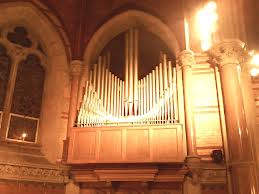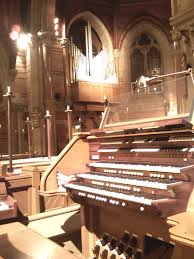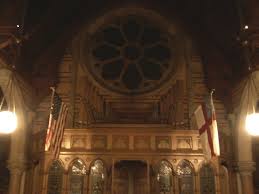Built in 1979 as Opus 2623 by Austin Organ Company of Connecticut, this instrument excellently supports congregational singing and choir accompaniment as well as respectably reproduces repertoire from many time periods. The pipework is distributed among six divisions (Great, Swell, Choir, Positiv, Antiphonal, and Pedal) and is located in several places around the nave creating a unique experience for listeners.
While this instrument sounds magnificent, we have reached a time where we are in desperate need of replacing the console. Although it was state of the art technology at the time, the console now is obsolete and makes it increasingly difficult to provide our high quality music to our congregation. Most notably, the console lacks a ‘solid state’ memory computer, so we are only able to use 14 general and less than 6 divisional presets at a time. (This is in comparison to contemporary technology that allows virtually unlimited memory levels with thousands of combinations). Although this may not be a terrible problem for one organist, given that we regularly feature both our Organist and Sub Organist on Sundays as well several Recitalists, these limitations manifest very quickly! Plans have begun to create a new 4-manual console that will house appropriate equipment to make our organ technologically contemporary again. Additionally, wear and tear on the organ as a whole calls for some major overhaul and repair. Plans have been rceived for a multi-phase renovation and upgrade of the organ system Costs for all phases range between $400,000 and $550,000. St. Luke’s actively invites anyone who deeply values the traditions of pipe organ music to help secure this magnificent instrument into this century. For more information, please contact the parish at (717) 272-8251 or send an email to the rector at rector@stlukeslebanon.org.
Make a one-time or continuing contribution to the St. Luke’s Organ Fund here:
Specifications of the Austin Organ
| Great (Epistle Side) 16’ Quintaten 8’ Principal 8’ Bordon 4’ Octave 2’ Spitzfifteenth II Sesquialtera IV Fourniture 8’ Trompette Chimes Swell 16, 8, 4 Choir 16, 8, 4 Positiv 8 Antiphonal 8 Great Off |
Swell (Gospel Side – enclosed) 16’ Rohrgedeckt (ext) 8’ Viole de Gambe 8’ Voix Celeste (TC) 8’ Rohrflote 4’ Principal 4’ Waldflote 2’ Blockflote III Plein Jeu 16’ Basson 8’ Trompette 4’ Hautbois-clarionTremolo Swell 16, 4, Off Choir 8  |
Positiv (Gospel Side) 8’ Holtzgedeckt 4’ Koppelflote 2’ Principal 1 1/3 Larigot III Cymbal 8’ Cromorne Cymbalstern Tremolo Positiv Off  |
Choir (Epistle Side – enclosed: 4″ wind) 8’ Hohlflote 8’ Flauto Dolce 8’ Flute Celeste 4’ Gemshorn Tremolo Choir 16, 4, Off Swell 16, 8, 4 Antiphonal 8 Great 8 |
| Antiphonal (rear gallery) 8’ Holtzbourdon 4’ Principal 2′ Oktav III Mixture 8′ Trompette en Chamade  Combination Pistons Combination Pistons14 general pistons 7 Great and 7 Swell pistons 4 Choir pistons 3 Antiphonal and 3 Positiv piston 6 Pedal toe studs Crescendo pedal Cymbelstern reversible toe stud Tutti reversible on piston and toe stud |
Pedal (2 1/2″, 3 3/8″, 4″ wind) 32’ Resultant 16’ Principal (ext. Gt.) 16’ Quintaten (Gt.) 16’ Rohrgedeckt (Sw.) 8’ Octave 8’ Rohrflote (Sw.) 4’ Choral Bass III Mixture 16’ Trompete (ext. Gt.) 16’ Basson (Sw.) 4’ Cromorne (Pos.) 16′ Bourdon (Ant.) 32′ Basson (resultant on toe stud 32′ Bombarde (resultant on toe stud) |
